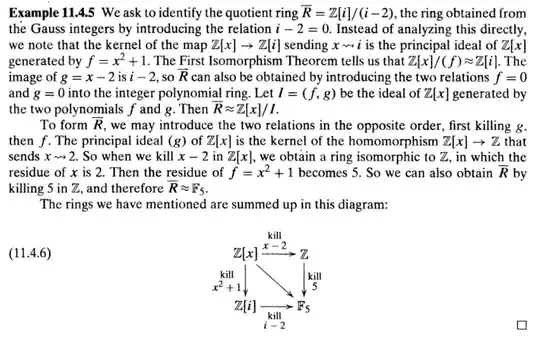I'm trying to apply exactly the same technique as demonstrated in this example from Artin's Algebra --  -- to the ring $\mathbb Z[x]/(5,x^2+3)$. In my case the top arrow from Artin's figure (11.4.6) corresponds to $\mathbb Z[x]\to \mathbb Z, x\mapsto 5$, and the residue of $x^2+3$ is $5^2+3=28$ (which corresponds to Artin's $2^2+1=5$). Shouldn't I get $\mathbb Z_{28}$ then? I was told that this answer isn't correct. But I don't get why I got the wrong answer by following exactly the same process as in Artin's example.
-- to the ring $\mathbb Z[x]/(5,x^2+3)$. In my case the top arrow from Artin's figure (11.4.6) corresponds to $\mathbb Z[x]\to \mathbb Z, x\mapsto 5$, and the residue of $x^2+3$ is $5^2+3=28$ (which corresponds to Artin's $2^2+1=5$). Shouldn't I get $\mathbb Z_{28}$ then? I was told that this answer isn't correct. But I don't get why I got the wrong answer by following exactly the same process as in Artin's example.
Asked
Active
Viewed 126 times
0
-
Why $x\mapsto 5$? It should be $x\mapsto\mathrm i\sqrt3$. – Vercassivelaunos Feb 13 '21 at 22:55
-
Oh, I think I see what went wrong then. $\mathbb Z_{28} $ would be isomorphic to $\mathbb Z[x]/(x-5,x^2+3)$. – user557 Feb 13 '21 at 22:58
-
Yes, that would make more sense. – Vercassivelaunos Feb 13 '21 at 23:02
-
I think that if you write down what $f$ and $g$ are for your example you will see the difference (your quotient involves "killing" $5$ not $x - 5$). – Rob Arthan Feb 13 '21 at 23:02
1 Answers
1
Artin's situation and yours are very different.
You can either first kill $5$ and then $x^2+3$ or conversely.
In the former case you first get $\mathbb{F}_5[x]$ and then $\mathbb{F}_{25}$, because the polynomial $x^2+3$ is irreducible over $\mathbb{F}_5$.
If you first kill $x^2+3$, you get $\mathbb{Z}[i\sqrt{3}]$ and here you need to find the quotient modulo the ideal generated by $5$. This adds a few complications, because $\mathbb{Z}[i\sqrt{3}]$ is not a PID, see Is $\mathbb Z[\sqrt{-3}]$ Euclidean under some other norm?
egreg
- 238,574
-
I think the usual way to calculate $\Bbb Z[\sqrt{-3}]/(5)$ is to pass it back to $\Bbb Z[X]/(X^2 + 3, 5)$ and then quotient out $5$ first. – WhatsUp Feb 13 '21 at 23:17
-
-
@user660670 You have to prove the ideal is maximal, in order to show that the quotient is a field. Since the ring is not a PID, this is not the same as proving the generator is irreducible. – egreg Feb 13 '21 at 23:28
-